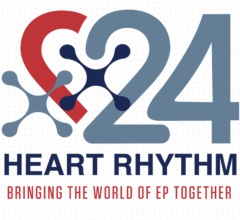
Getty Images
May 18, 2022 — A new app developed by the Mayo Clinic transmits Apple Watch electrocardiograms (ECG) signals recorded in non-clinical environments seamlessly and securely to the medical center to permit artificial intelligence (AI) analysis to identify leftventricular dysfunction, a life-threatening, asymptomatic heart disease. Additionally, the tracings are presented on an interactive dashboard integrated with the electronic health record to facilitate clinician review. The findings were presented today as late-breaking clinical science during Heart Rhythm 2022.
Heart failure is a progressive disorder that impacts more than six million Americans and leads to more than one million hospitalizations annually1. Considered stage B heart failure, left-ventricular dysfunction is often asymptomatic and, if left untreated, can lead to adverse events. Traditional ECGs are unable to identify and diagnose ventricular dysfunction (weak heart pump), even with expert human interpretation. The introduction of AI to 12 lead ECG analysis in a clinical setting enabled the ECG to identify left ventricular dysfunction. The authors of this study sought to adapt the neural network so that instead of reading a 12 lead ECG, it could read an Apple Watch ECG to assess applying the test remotely and, by using patient-owned equipment, inexpensively.
Mayo Clinic patients with the Mayo Clinic iOS app and an Apple Watch were invited to participate in the study. Of the 3,884 Mayo Clinic patients who reported Apple Watch ownership, 2,454 subjects from 46 states and 11 countries participated and downloaded the study app. The average age of participants was 53±15 years and 56% were female. The app, developed by Mayo Clinic, sent all previously recorded ECGs for clinician review. ECGs acquired from the wearable devices within one month of a clinically ordered ECG were analyzed by AI for the presence of ejection fraction ≤40% using a model adapted for single lead use.
“We have seen how artificial intelligence has revolutionized the already common ECG into a tool that can be used to identify occult cardiovascular diseases. Our team saw vast potential to expand tracking outside of a physician’s office by using popular wearable devices,” said Zachi Itzhak Attia, MSEE, PhD, Mayo Clinic. “We set out to create a platform that could not only provide accurate readings, but also would yield high patient engagement with an easy to navigate, user-friendly process that can be completed from the comfort of a patient’s home.”
Between August, 2021 and August, 2022, patients shared 125,610 ECGs and 92% of patients used the app more than once. Of the participants, 421 had at least one sinus rhythm (NSR) ECG (avg: 17 ECGs, with NSR determined by watch algorithm) within 30 days of an echocardiogram. Among the participants, 16 of these patients (3.8%) had an EF ≤40%, and 13 out of these 16 patients were identified by the watch AI ECG, which had an Area Under the Curve (AUC) 0.875, sensitivity 81.2% and specificity 81.3%.
“These findings show that the application of AI to a wearable device ECG can effectively monitor left ventricular dysfunction. For patients who might unknowingly have this condition, such as those with hypertension, diabetes, advancing age, and people receiving some forms of chemotherapy, the tool could enable early detection and help physicians optimize treatment options,” said Paul Friedman, MD, FHRS, Mayo Clinic. “This technology has the potential to be scaled and adopted by hospital systems to better serve patients, particularly in remote communities or geographically diverse populations around the world, potentially addressing health care disparities, and enabling physicians to offer more coordinated patient care.”
The authors are currently seeking FDA approval for the current algorithm used in this trial, and would like to see further studies test additional AI algorithms developed by their team. They would also like expand this current interface for additional data collection and to screen for other common heart conditions among patients, such as atrial fibrillation.
For more information: www.hrsonline.org
Reference:
1 Mozaffarian D, Benjamin EJ, Go AS et al. Heart disease and stroke statistics – 2015 update: a report from the American Heart Association. Circulation. 2015;131:e29–322. doi: 10.1161/CIR.0000000000000152.
Related content:
Use and Benefits of RPM in a Clinical Setting
Mayo Researchers Use AI to Detect Weak Heart Pump via Patients’ Apple Watch ECGs
Related Content on Wearables and Big Data in Healthcare:
New Fitbit Feature Makes AFib Detection More Accessible
Tracking Cardiovascular Health Population Trends Using Consumer Wearables
Bristol-Myers Squibb-Pfizer Alliance, Fitbit Team Up on Atrial Fibrillation Detection
Artificial Intelligence Detects AFib Using Apple Watch Heart Rate Sensor
Consumer Smart Watches Accurately Measure Paroxysmal Supraventricular Tachycardia
VIDEO: Use of Wearable Medical Devices for Cardiac Rehabilitation — Interview with Robert Klempfner, M.D.
VIDEO: Mobile App Links Wearable Data to Electronic Medical Records
Apple Heart Study Demonstrates Ability of Wearable Technology to Detect Atrial Fibrillation
VIDEO: Use of Wearables to Track Electrophysiology Patients — Interview with Khaldoun Tarakji, M.D.
VIDEO: The Future of Wearables in Healthcare — Karl Poterack, M.D.
8 Cardiovascular Technologies to Watch in 2020


 July 30, 2024
July 30, 2024 








